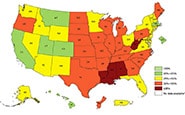H1 - Adult Obesity Facts
H4 - Card Heading

Obesity
Prevalence Maps
Adult obesity prevalence by state and
territory using self-reported information from the Behavioral Risk
Factor Surveillance System.
H2 - Obesity is common, serious, and costly
- The prevalence of obesity was 29H2 - .8% and affected about 93.3 million of US adults in 2015~2016. [Read CDC National Center for Health Statistics (NCHS) data briefCdc-pdf PDF-603KB]
- Obesity-related conditions include heart disease, stroke, type 2 diabetes and certain types of cancer that are some of the leading causes of preventable, premature death. [Read guidelinesExternal]
- The estimated annual medical cost of obesity in the United States was $147 billion in 2008 US dollars; the medical cost for people who have obesity was $1,429 higher than those of normal weight. [Read paperExternal]
H3 - Obesity affects some groups more than others
[Read CDC National Center for Health Statistics (NCHS) data briefCdc-pdf [PDF-603KB]]
- Hispanics (47.0%) and non-Hispanic blacks (46.8%) had the highest age-adjusted prevalence of obesity, followed by non-Hispanic whites (37.9%) and non-Hispanic Asians (12.7%).
- The prevalence of obesity was 35.7% among young adults aged 20 to 39 years, 42.8% among middle-aged adults aged 40 to 59 years, and 41.0% among older adults aged 60 and older.
H4 - Obesity and socioeconomic status
H5 - [Read the Morbidity and Mortality Weekly Report (MMWR)]
H5 - Read the Morbidity and Mortality Weekly Report (MMWR)
H6 - The association between obesity and income or educational level is complex and differs by sex and race/ethnicity.
- Overall, men and women with college degrees had lower obesity prevalence compared with those with less education.
- By race/ethnicity, the same obesity and education pattern was seen among non-Hispanic white, non-Hispanic black, and Hispanic women, and also among non-Hispanic white men, although the differences were not all statistically significant. Although the difference was not statistically significant among non-Hispanic black men, obesity prevalence increased with educational attainment. Among non-Hispanic Asian women and men and Hispanic men there were no differences in obesity prevalence by education level.
- Among men, obesity prevalence was lower in the lowest and highest income groups compared with the middle income group. This pattern was seen among non-Hispanic white and Hispanic men. Obesity prevalence was higher in the highest income group than in the lowest income group among non-Hispanic black men.
- Among women, obesity prevalence was lower in the highest income group than in the middle and lowest income groups. This pattern was observed among non-Hispanic white, non-Hispanic Asian, and Hispanic women. Among non-Hispanic black women, there was no difference in obesity prevalence by income.
H4 - Related Links
-
Obesity
Prevalence Maps
State-specific data on adult obesity prevalence using self-reported information from the Behavioral Risk Factor Surveillance System (BRFSS) shows that obesity prevalence remains high in the United States.
Page last reviewed: August 13, 2018
